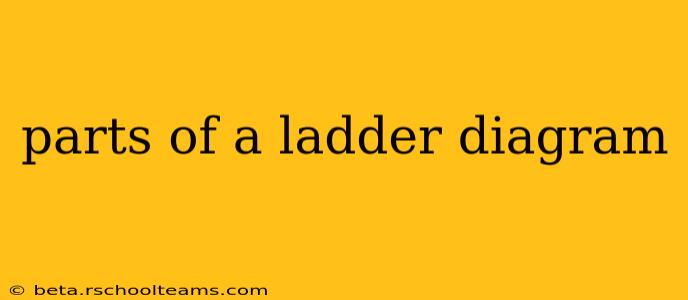Ladder diagrams are the backbone of many industrial control systems, providing a clear and concise visual representation of how electrical circuits function. Understanding their parts is key to comprehending how these systems operate and troubleshoot potential problems. This guide breaks down the essential components of a ladder diagram, making them accessible to both beginners and experienced professionals.
What are the Main Components of a Ladder Diagram?
A ladder diagram resembles a ladder, hence the name. It's composed of several key elements working together to illustrate the logic of a control system. These include:
-
Power Rails: These are the vertical lines on either side of the diagram, representing the power supply. One rail typically represents the positive voltage (+V) and the other the negative voltage (0V or ground). They are the source of power for the entire circuit.
-
Contacts (Normally Open & Normally Closed): These are represented by symbols that show the state of a switch or sensor. There are two main types:
-
Normally Open (NO) Contacts: These contacts are open (no connection) when the input is inactive (e.g., a switch is off or a sensor is not detecting something). They close (make a connection) when the input is active. They are symbolized by a pair of lines that are not connected unless activated.
-
Normally Closed (NC) Contacts: These contacts are closed (making a connection) when the input is inactive and open when the input is active. They symbolize a connection that breaks when activated.
-
-
Coils (Outputs): These represent the loads or actuators in the system, such as motors, lights, solenoids, or valves. They are energized (activated) when a complete circuit is established through the corresponding logic network of contacts. Coils are symbolized by a circle with a line inside.
What other symbols might appear on a ladder diagram?
Beyond the basics, you'll encounter additional symbols representing more complex elements within a control system. These can include:
-
Timers: These introduce time delays into the circuit's logic, delaying the activation or deactivation of outputs.
-
Counters: These track the number of times a specific event occurs and can activate outputs based on a predetermined count.
-
Logic Gates (AND, OR, NOT): These symbols depict Boolean logic functions allowing for more complex control scenarios.
-
Function Blocks: These represent specific functions or algorithms, often used in programmable logic controllers (PLCs).
-
Jumpers: These are used to simplify diagrams with repetitive sections by creating a jump to another part of the diagram.
How are rungs used in a Ladder Diagram?
The horizontal lines connecting the power rails are called rungs. Each rung represents a separate circuit that controls a specific output. The arrangement of contacts on a rung dictates the conditions necessary to energize the coil on that rung. For example, a rung might contain multiple NO contacts in series, meaning all contacts must be closed for the coil to energize. Alternatively, NO contacts in parallel mean that only one contact needs to be closed for the coil to energize.
How do I read a Ladder Diagram?
Reading a ladder diagram involves tracing the path from the positive power rail to the negative rail. If a continuous path exists through the contacts, the coil at the end of the rung will be energized. This involves careful consideration of the state of each contact based on the system's inputs.
What are some common applications of Ladder Diagrams?
Ladder diagrams are widely used in numerous applications, including:
- Industrial automation: Controlling machinery, processes, and production lines.
- Building automation: Managing HVAC systems, lighting, and security systems.
- Process control: Monitoring and regulating chemical processes, power generation, and water treatment.
Understanding the components of a ladder diagram is crucial for anyone working with industrial control systems. By grasping the fundamentals of power rails, contacts, coils, and rungs, you can begin to decipher and even design the logic controlling complex machinery and processes. Further study into specific symbols and functions will expand your capabilities within this critical field.
